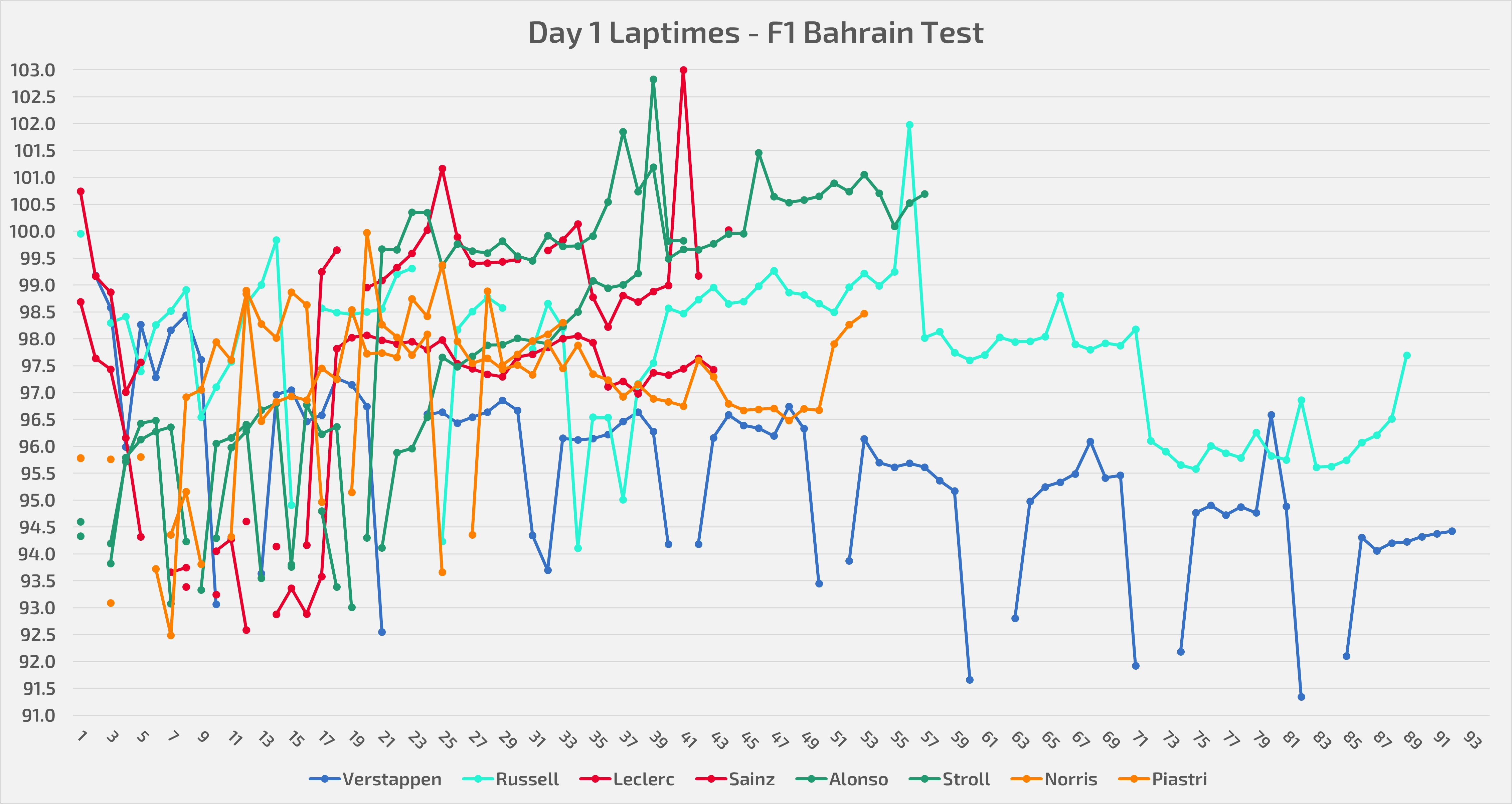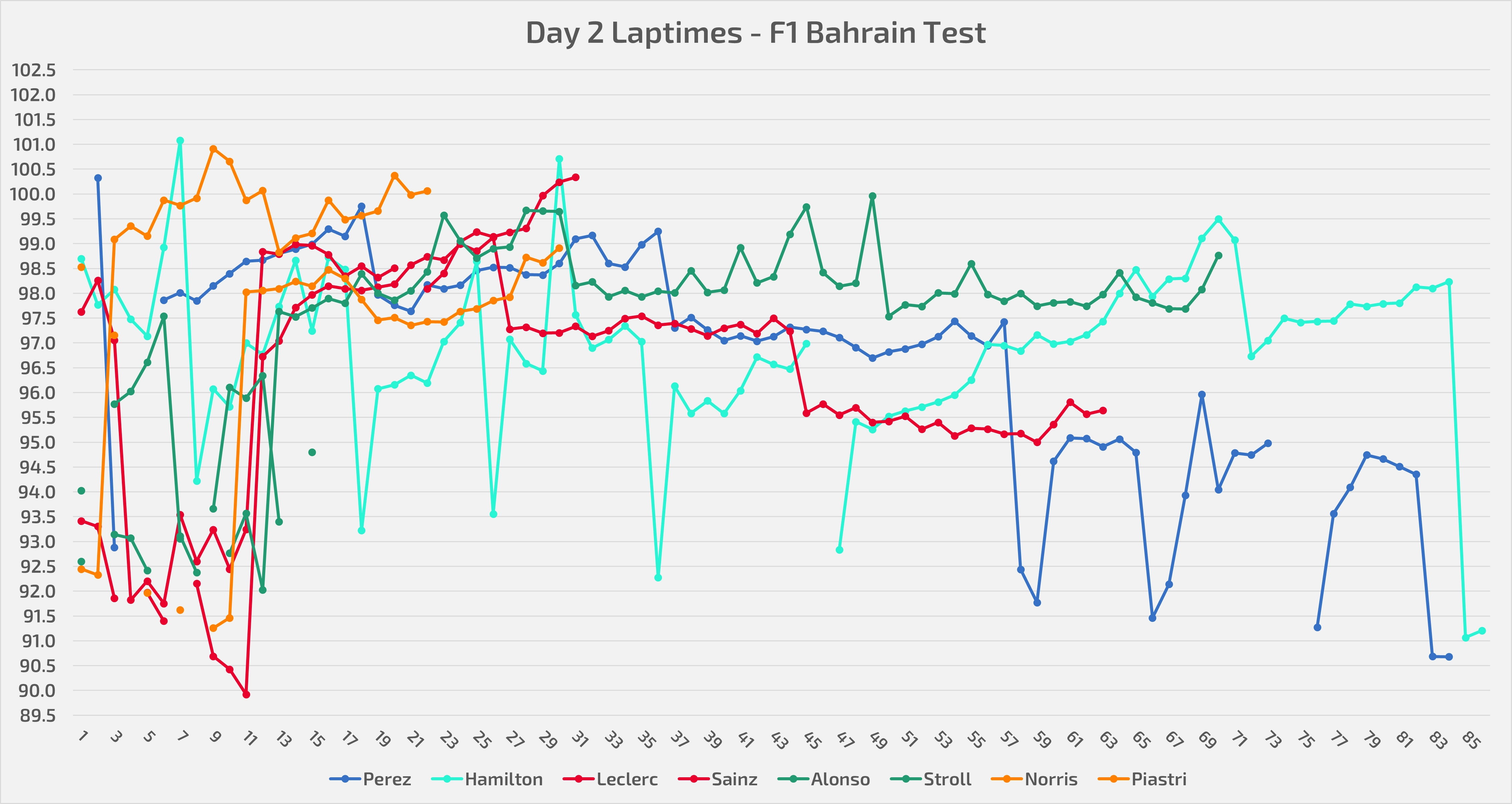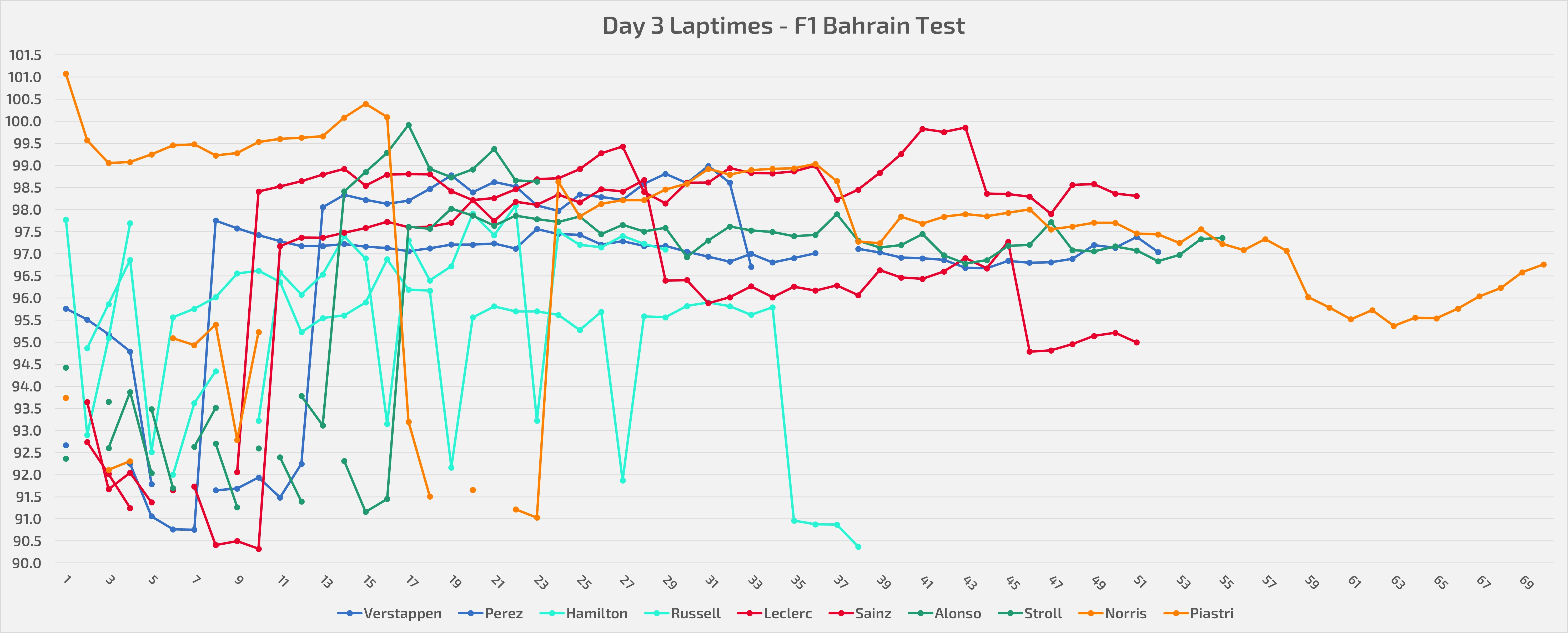
Pre-Season Test Considerations: Red Bull still in the lead, Ferrari ahead of the chasing pack!
(Cover picture: Scuderia Ferrari)
Hi everyone!
The pre-season tests in Bahrain have been concluded, and few days are left until the start of the first Grand Prix of the season, also in Bahrain. As always, carrying out a performance analysis from the tests is a complicated exercise, considering all the unknowns linked to the work carried out by the teams: aero-mechanical setups, fuel loads, engine maps and driver commitment during his best laps are just some of the question marks that the bare laptime classification leaves us with when the sun goes down on the Sakhir circuit.
Steven Tee / Motorsport Images
For this reason (and given the imminence of the Bahrain GP, which will give us much more truthful feedback), instead of our canonical performance analysis, I would like to leave here some considerations on what we saw in each of the 3 days of testing: of course, the conclusions we are going to draw are in any case linked to the analysis of the results that emerged, but the approach of this analysis aims to be - given the peculiar circumstances - a little more qualitative and a little less quantitative than usual.
Day 1: Red Bull simply unstoppable, see you next year!
🏁 DAY ONE CLASSIFICATION 🏁
— Formula 1 (@F1) February 21, 2024
Verstappen leads the way, chased by Norris, Sainz and Ricciardo 👀#F1Testing #F1 pic.twitter.com/CIQYiaOULM
The first of the three scheduled days saw a strong start by all teams, who wanted to waste as little time as possible in these first 8 hours of testing: risking a major technical issue would have meant giving up a third of the overall mileage available, which - in a Formula 1 increasingly dominated by simulations - is unacceptable for any technical department.
From this point of view, however, apart from the low number of laps by the two Williams drivers, all the others completed enough laps to validate their single-seater configurations brought to Sakhir, starting from that moment on a very first phase of aerodynamic development. In terms of work programs, it's interesting to note how a different methodology was adopted in each box: someone immediately tried time attacks (despite all the above-mentioned unknowns), others attempted real race simulations, others still - see Verstappen's Red Bull - remained a little hidden and splitted their race simulation into many small stints, refuelling between one and the other to distort the results available to their opponents.

Laptimes set on Day 1 of the Bahrain testing
Despite this desire to hide, Verstappen's ease of driving and the consequent laptimes obtained immediately made a difference compared to their rivals, which immediately foreshadowed a clear-cut domination by the reigning World Champions... As you can see in the image above, in fact, it's clear how the laptimes set by Max and his brand new RB20 are constantly lower - even on stints that aren't very short.
Steven Tee / Motorsport Images
What is surprising is not so much the quality of the new single-seater from Milton Keynes, but the fact that their technical baseline immediately appeared in need of very few corrections despite an aerodynamic upheaval compared to the well-known last year's RB19. It was at that moment, more than at any other, that it became clear to me how useful it was for Red Bull to freeze their development during last year's summer: from that moment on, technical resources were focused on the new car, and the results are plain for all to see...
Photo: Motorsport Images
A less flashy day for Ferrari, which also appeared to have little interest in the search for amazing laptimes: the work of the team based in Maranello focused on a scan of the various ride heights and mechanical adjustments of the new SF-24, all contributing to create what is called the "aero map" of the car. Such a map defines what the achievable limits are in terms of setup, from one extreme to the other: in this type of work it's crucial to obtain a strong correlation between the aerodynamic map emerging from the simulations compared to the real one, observed on track ... Only if this correlation is verified (and for the SF-24, unlike last year, it seems to have been the case), they can start with the first updates introduction.
Sam Bloxham / Motorsport Images
The team that, apart from Red Bull, surprised me the most was RB (which would be "Visa CashApp RB", but from now on we will shorten it to "RB"). The VCARB 01, brought to the track on the first day by both Ricciardo and Tsunoda, proved to be very competitive right from the start: leaving aside the 1'32"599 which earned Ricciardo the fourth fastest laptime overall, also in this case what struck me was the ease of driving that this car allowed the Australian driver. If it's true that a lot has been inherited from the 2023 Red Bull RB19, I believe that in the first part of the season the two drivers of the Faenza team will be able to be regular visitors of the points paying positions...
Day 2: What's the real performance of the Ferrari SF-24?
🏁 DAY 2 TESTING CLASSIFICATION 🏁
— Formula 1 (@F1) February 22, 2024
Plenty of laps in the bag, and @Carlossainz55 on top! 🔝🌶️#F1Testing #F1 pic.twitter.com/PA40dw3ykp
The second day saw a significant reduction in laptimes, with more qualifying simulations performed and some runs on C4 compound tyres, which are very soft (and that's why they won't be used in the first Grand Prix, where we'll only have C1, C2 and C3 at disposal). The absolute best laptime was set by Carlos Sainz, who achieved a 1'29"921 which in retrospect was never bettered until the very end of the tests.
Steven Tee / Motorsport Images
An important laptime that finds no terms of comparison with the same compound, and which for this very reason risks being little indicative of the technical quality of the Ferrari SF-24. However, the race simulation carried out in the afternoon by Sainz himself did justice to the latter: a lot of speed combined with excellent performance from the tyres, which surprisingly degraded much less than what we used to see with the SF-23. In short, this was the moment in which the Maranello team put in its most encouraging performances of the 3-days in the Middle East.

Laptimes set on Day 2 of the Bahrain testing
The gap with the other top teams was surprisingly big in favor of Ferrari, which while it may mean having "showed their cards" more than the others, also ensures a "safety margin" when everyone will be forced to pull out the maximum performanceallowed by their cars. But as said for Red Bull following the first day, there are many unknowns that stand in the way of an objective performance analysis, and if we were to judge Ferrari's Thursday only on the basis of the laptimes set, we could say that the Maranello team would be capable of winning the World Championship with ease... Obviously we know well that this isn't the case, which is why we need to be careful in our judgements, both ways!
Zak Mauger / Motorsport Images
Another team in good shape on Day 2 was McLaren, which we have talked about little so far, mainly because the Woking-based team was very careful to go unnoticed, starting from the presentation of the MCL38, up to the tests de quo. Despite this, I feel like saying that both Norris and Piastri appeared in a state of great confidence with their car, especially in the longer stints (therefore with a slightly higher fuel load). Wanting to establish a scale of performance levels that also takes into account Day 3 - on which we'll focus immediately - I would say that McLaren seems a step below Red Bull and Ferrari, pretty much in the same "areas" in which there should also be Mercedes and Aston Martin, perhaps struggling more with Stroll behind the wheel.
Day 3: back on 2023 performance levels once again, much ado about nothing?
#F1TESTING: DAY 3 CLASSIFICATION 👀
— Formula 1 (@F1) February 23, 2024
Leclerc on top ahead of our first race next *Saturday*#F1 pic.twitter.com/6ZMUFAnLAf
Finally, let's come to the third and final day of testing at Sakhir, the last chance for everyone to drive on track before the FP1 session of the Bahrain Grand Prix.
Also on this occasion, the best laptime of the day was once again set by a Ferrari, this time with Charles Leclerc at the wheel, in 1'30"322 (again on C4 compound tyres). Regarding the fastest laptime, the usual disclaimers - made a million times by now at this point in the article - do apply; much more important to note that, for the first time in all 3 days, Mercedes also dedicated themselves to qualifying simulations similar to those carried out by Ferrari.
Sam Bloxham / Motorsport Images
In fact, with George Russell at the wheel, the last two hours of testing were dedicated to qualifying runs on C4 tyres which brought the Englishman to second position, with 1'30"368. It's a pity that, similarly to what Red Bull, even Mercedes didn't complete a full race simulation from start to finish, limiting themselves to medium-length stints interspersed with "strategic" pit stops with refuelling...

Laptimes set on Day 3 of the Bahrain testing
Moving for a moment from the top teams to the medium-low ranking teams, Guanyu Zhou's qualifying run (third in 1'30"647) aboard his Kick Sauber C44 is in my opinion to be considered as a "glory run", one of those attempts to attract sponsors with very fast laptimes (but already well close to the limit allowed by their single-seater) rather than an showing of "genuine" performance.
Steven Tee / Motorsport Images
The Swiss team will probably have achieved some improvements since last year's disastrous season, but to say that these could be enough to climb positions in the Constructors' Championship seems exaggerated to me, especially given how the teams are lining up in the field: with 6 teams (Red Bull, Ferrari, McLaren, Mercedes, Aston Martin and RB) one step above the other 4 (Kick Sauber, Williams, Alpine and Haas), it will be very difficult for the latter to consistently run points-scoring races.
The Bahrain Grand Prix will give us the answers that we've been waiting for months...
The considerations expressed were necessary to give some insight into how the teams worked in the very limited time available to them before the official start of the 2024 World Championship. I reiterate that drawing up a prediction in view of the first race is an exercise with a high error rate, so we won't venture into such speculations: on the other hand, the first race weekend is just around the corner, and we won't have to wait long to find out if the first starting grid of 2024 will be much different from what the tests have shown us.
See you in the next few days: watch this space to talk about a World Championship that we hope will be competitive and exciting!
Index
Pre-Season Test Considerations: Red Bull still in the lead, Ferrari ahead of the chasing pack!